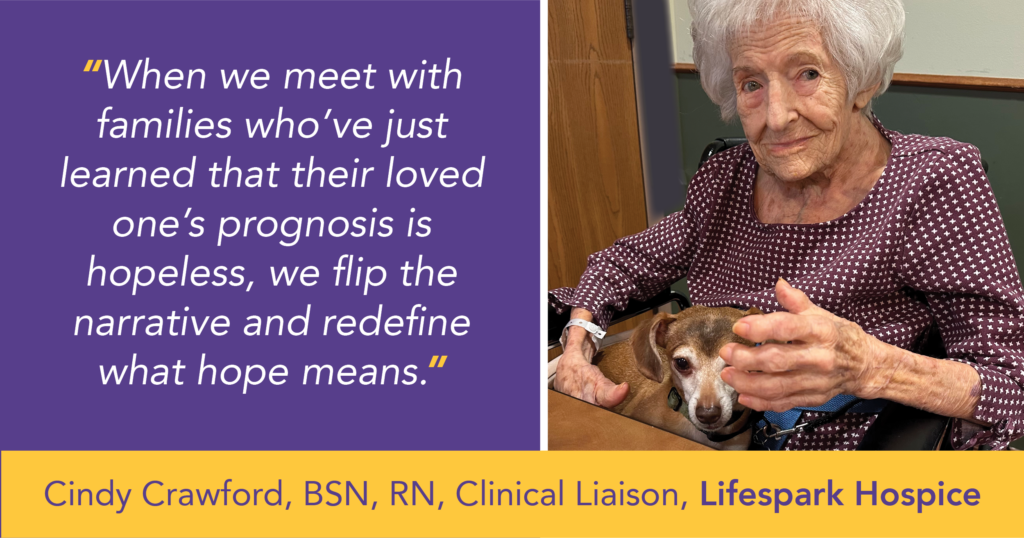
The modern hospice movement was founded nearly 60 years ago, yet even today, hospice suffers from an image problem that often prevents people from taking advantage of this life-enhancing health care benefit. Cindy Crawford, BSN, RN, Clinical Liaison, Lifespark Hospice, is passionate about debunking hospice myths and helping clients and families understand that hospice can improve quality of life and potentially extend it, too.
During her initial consultations, Cindy spends time getting to know the client, their wishes, goals of care, fears, and beliefs. Through education, clinical evidence, and open dialogue, she works to dispel long-held myths and gain her clients’ trust. But it can take time.
Recently, a Lifespark physician suggested she accompany him on a visit with a Lifespark COMPLETE member, an 88-year-old man with end-stage heart failure, multiple myeloma, and symptoms of nausea. “When I started talking about hospice, he immediately put on the brakes, because in his mind, hospice meant death and dying,” Cindy said. “I realized it might take more than one conversation before he could make an informed decision.” They continued to meet, and after three weeks, the client decided he was ready for hospice. He passed away 30 days later.
Improving and extending life
One of the most deeply entrenched myths is that hospice hastens death. Although the median length of stay on hospice care is just 18 days, hospice itself has been shown to extend life by an average of 29 days.
One likely reason is effective pain and symptom management, thanks to medications that can be prescribed for late-life care. “I was working with a woman whose severe COPD [chronic obstructive pulmonary disease] had left her housebound, yet she refused to use morphine to help her breathe,” Cindy said. “Eventually, she allowed me to give her a small dose from one of their pre-filled syringes, and almost immediately, she felt better.”
Her husband later reported that because his wife was able to walk to the car, he decided to drive them to a favorite park where they spent the afternoon together. By reducing the client’s breathlessness, the medication enhanced the quality of her life—and his, Cindy said.
Cindy’s colleague, Kelly Pritchard, ADN, RN, Clinical Liaison, Lifespark Hospice, has had similar experiences with clients and family members who see hospice as a death sentence. In those cases, she’ll talk about late-life care rather than hospice to ease their fears and soften their resistance.
“I try to focus on the support they’ll get from nurse practitioners, nurses, in-home aides, social workers, massage therapists, music therapists, and chaplains who are experts in this stage of life,” Kelly said. “I’ll also talk about the convenience of hospice—they won’t have to go to the pharmacy for their meds, if they need a hospital bed, we can have one delivered in just hours, instead of days or weeks, and if they need help at 2:00 AM, a nurse will come to their home.”
Occasionally, clients will even discharge off hospice, Kelly said. “Factors like more frequent nursing visits, extra help from home health aides, medications that reduce pain, a social worker who arranges a move to a higher level of care—all of these can help restore a person’s health to the point where they graduate from hospice,” she said, adding that clients can always reenroll if or when their health declines.
Redefining hope
When Cindy gets a call from a hospital or a transitional care facility, she knows that the client and their family have just been told that there’s nothing more the doctors can offer them. “We need to be able to walk into that environment with positive energy and a spirit of hope, because there is so much we can do for them—emotionally, socially, and spiritually,” she said. “To quote the founder of modern hospice, Dame Cicely Saunders, ‘You matter because you are you, and you matter to the end of your life. We will do all we can not only to help you die peacefully, but also to live until you die.’”
As Cindy explained, Ms. Saunders believed that even when a cure isn’t possible, quality of life can still be significantly improved. “When we meet with families who’ve just learned that their loved one’s prognosis is hopeless, we flip the narrative and redefine what hope means,” Cindy said. “The dying are still living, so our role is to open the door to encourage and enhance someone’s late life experience.”
Quality time
I can personally attest to the life-giving effects of hospice. Soon after we moved my 91-year-old mother into memory care, she started fading away, physically, socially, and mentally. Less than a year earlier, she’d gone canoe-camping, cross-country skiing, and hiking, but now, whenever I came to visit, I’d find her fast asleep in a recliner. She’d become too weak to stand without help, she couldn’t feed herself, and her voice was almost inaudible.
By itself, dementia wouldn’t have qualified my mom for hospice, but the combination of her progressive weight loss, silent choking events, and extreme frailty met the criteria for Lifespark Hospice.
At our first meeting, Dr. Lor, the medical director at Lifespark Hospice, deprescribed two medications she’d been on for atrial fibrillation, a condition that had been detected just days before her move to memory care. The change in my mom was immediate. She still had advanced dementia, of course, but suddenly, she was awake and alert, using her walker to stand up by herself, playing seated kickball, waving pool noodles, and feeding herself. Best of all, she got her quirky sense of humor back.
My mom lived another seven months, thanks to the excellent care from the staff and the Lifespark Hospice team. My sisters and I will be forever grateful.
To connect with a Hospice specialist, visit Lifespark Hospice.
Blog photo: Hilde and Figaro, one of our hospice volunteer’s certified pet therapy dogs



